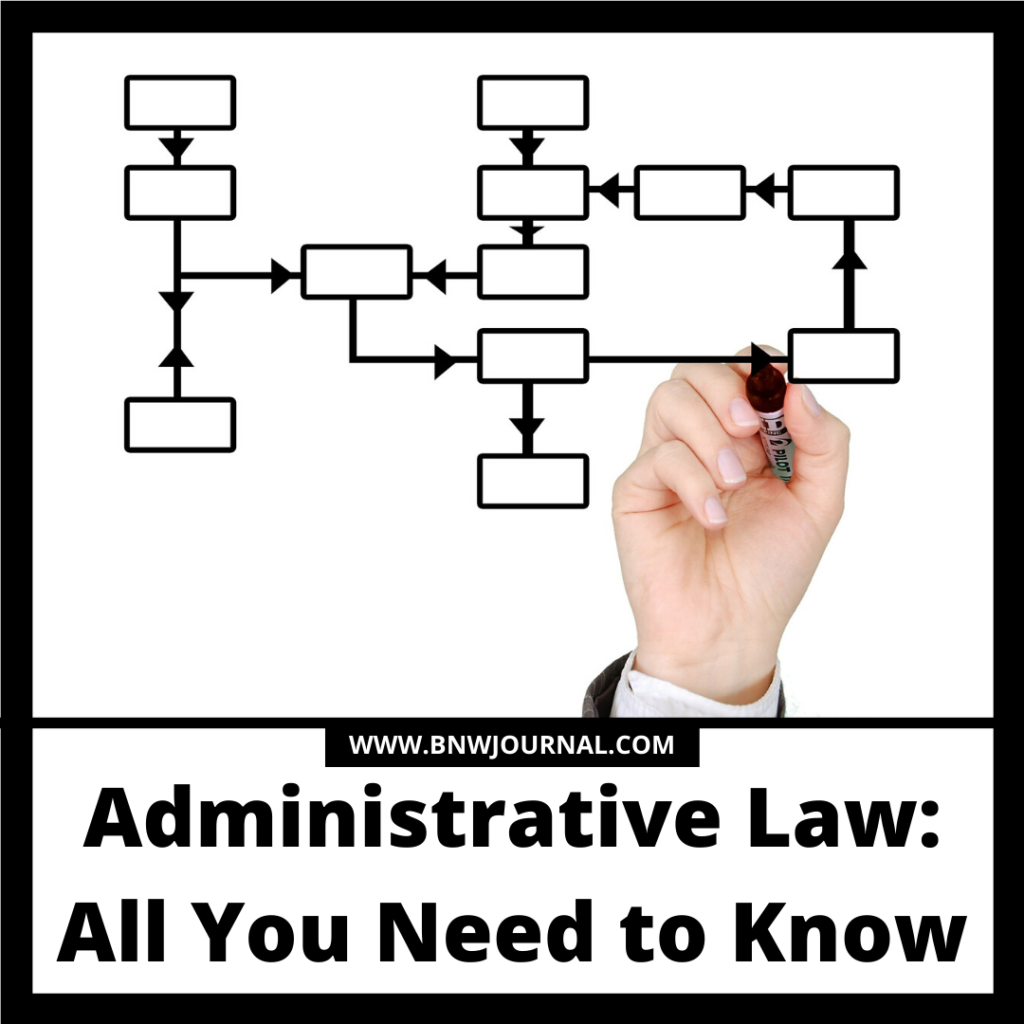![]()
Introduction
One of the stellar developments in law is the birth of Administrative Law. What came to be a part culled out of constitutional law, it was not just a result of its need to be a separate legal discipline in the 19th century. But also a reflection of how the administration has been a vital part of Indian legal history since the time of the Mughals and Mauryas. This article will be a sneak peek into what administrative law is all about.

Meaning and Emergence
When defining Administrative law, many jurists have spoken about administrative actions and procedures. Sir Ivon Jennings[1] states that “Administrative Law is the law relating to administration, it determines the organization, powers, and duties of administrative authorities”. And KC Davis[2] defines that “It is a law which is concerned about powers as well as procedures of the administrative agencies including especially the law governing judicial review of administrative action”. Many working definitions have come about to thrive due to its rich history. Parochially, which later was extended to nations all over the world.
Like most modern tools of government, the administration can be traced back to the Romans. Augustus, I ordered that the queries and grievances regarding the trusts of Anglican law, fidei commissa[3] was not to be managed by one of the praetors of justice but to be assigned to the consuls to be dealt administratively. He made the positions of fiscus caesurius whose job was to collect revenue which “consisted of farming out the taxes to the highest bidder (maximis parties)”[4] Emperor Claudius was also the pioneer that looked into the concept similar to that of an administrative tribunal way back in the Roman period. This might have gone untraced but had laid a solid base for the seeds of administrative law to grow.
Moving further, France had a notable administrative law system that serves as an inspiration to many countries till date. It was the legendary droit administratif[5].
According to Dicey, it worked on two principles that may have caused the revolutionary stir it did.
- One, the government and every servant of the government possess some special powers, rights, and privileges as against private citizens. This is for the simple reason they discharge sovereign functions.
- And two, the concept of separation of powers the executive, legislature, and the courts must be prevent from encroaching upon each others’ domains or province.
This system called for setting up of two courts: ordinary courts and administrative courts. They also had the provision of appeals and separate administrative justice delivery and administrative advice specific bodies such as the Conseil D’etat and Conseil du roi created in 1799.
The United Kingdom also contribute significantly to the growth of administrative law. However interestingly the whole concept of administrative law was denied by British jurists. Dicey and others in 1885. In 1929, Lord Donoughmore Committee recommend for better publication and control of subordinate legislation. The legal maxim that the king can do no wrong, abolish. And the scope and extent of administrative law was expanded by the Crown Proceeding Act, 1947. The civil proceedings were entertained against the Crown at par with a civilian. The Tribunals and Inquiries Act, 1958 then passed, helped with ensuring the overlooking of administrative decisions. The birth of the Henry VIII clause also deserves a special mention, for it is an area of administrative-judicial dilemma.
The case of the United States is peculiar due to its deep-rooted principle of separation of powers, horizontally and vertically. It led to a lucid system of administrative law. The regulatory agencies and committees were the first of its kind. A special committee was set up to look into the need for administrative law. It is as a result of the study conduct by Goodnow in 1933. Ironically, this itself looks like an example of an administrative body working its powers of administration. Post the committee’s sitting, in 1939 an Attorney General’s committee was set up. Its debate and deliberations led to the formation of the statute- Administrative Procedures Act, adopted in 1946. This legislation codifies the powers and functions of an administrative body and also provides for a judicial review of administrative action.
Drawing inspiration from all the above countries and injecting its creativity in employing administrative actions, Administrative law in India stands tall. But what is this creativity and how far can it go?
Nature and Scope
An administrative action can be said to be that which is not purely legislative or judicial and deals exclusively with the executive according to C.J Mukherjea in Ram Jawaya Kapur[6]. By this means, any executive action perform by a body, instrumentality, or agency of the state in furtherance of governmental function will be an administrative action. In the decision of RD Shetty[7], it has been decided as what qualifies to be those above institutions and it is namely
- (i) If the entire share capital of the corporation is held by the Government
- (ii) Where the financial assistance of the State is so much as to meet almost the entire expenditure of the corporation, it would afford some indication of the corporation being impregnated with governmental character.
- (iii) whether the corporation enjoys monopoly status which is the State conferred or State
- protected.
- (iv) ‘Existence of ‘deep and pervasive State control
- (v) ‘If the functions of the corporation are of public importance and closely related to governmental functions
- (vi) if a department of Government is transferred to a corporation[8]
The actions of such bodies can be construed to be administrative actions. While this describes what can be the nature of the bodies, it does not talk about the scope of actions.
Administrative Law deals with the structure, powers, and functions of the organs of administration; the limits of their powers; the methods and procedures followed by them in exercising their powers and functions; the methods by which their powers are controlled including the legal remedies available to a person against them when his rights are infringed by their operation.[9] In short, any action made by the executive in the furtherance of social welfare and that does not override an individual’s rights.
Types of administrative function
As the previous section saw the nature and scope of administrative bodies, this will deal with what are the types of functions. The executive authorities issue orders and make decisions that affect an individual’s rights and duties positively. While the nature of these functions seem partly legislative and judicial, these are taken by the administrative authorities solely. Namely, the administrative functions can be quasi-legislative, quasi-judicial functions, and purely-administrative.[10]
The legislature is the law-making body that lays down the statutory guidelines that help the executive in dispensing functions. However, the burden of legislation falls on the legislature and it is practically impossible to draft provisions so detailed. It gives no space for the administration to creatively execute its functions. Here is where delegated legislation comes to play. The legislature covers concepts relating to the general principles of the subject and the rule-making on the subject matter is conferred on the administrative body. Delegated legislation works only if the policy is clearly laid out by the legislature. Only then the delegatee is empowered to carry out the policy within the guidelines laid down by the legislature.
Thus, it is the quasi-legislative function of administration in the form of subordinate legislation making power. For example, if the legislation confers powers on the executive to take measures it deems fit in the case of an epidemic, the executive body, say the medical research body can issue orders or directions to the citizens. It is also important to note that no essential legislative function can be delegated.
The administrative authorities do not necessarily make decisions that affect the routine functioning of private bodies and individuals. The judiciary may not be able to delve into all the spheres that enable the social welfare of the citizens. Hence, the adjudicatory powers of the quasi-judicial nature are awarded to the administration. These powers are predominantly dealing with the presentation of the case and looking into the evidence and rarely furthering legal arguments. The bodies need to act in the capacity of administrative agencies dispensing judicial decisions and need to observe the principles of natural justice under any cause. For example, in the case of the Securities and Exchange Board of India and its discretionary power to take up an inquiry concerning insider trading. It should give the accused a reasonable chance to present his side before proceeding with the decision to prevent any arbitrariness.
Lastly and most importantly purely administrative function. A residuary function that is neither legislative or judicial can be said to be a purely administrative function. Administrative functions are generally based on a government policy and there is no judicial approach involved in this process. Although needless to say, this needs to be undertaken following the principles of fairness. This function could be further divided into three types: Administrative discretion, Administrative instruction, and Ministerial action. Administrative discretion can be said to be that window via a statute which gives leeway to the authorities to exert their powers.
As it is impossible to jot down all the contingencies. Administrative instructions emanate from administrative power and not from any statute and may be general or specific and vary in binding value. These cannot be said to laws and have the position of ‘articles of association’ in a company. Ministerial action is the action that an authority is expected to follow exactly as per the statute enables them to.
The three functions being explained, it is important to state that while an organ of the state can be differentiated categorically as the legislature, executive and judiciary. It is difficult to assess and appropriate the function undertaken by those bodies as necessarily belonging to that respect agency that undertook it.[11]
Sources of Administrative Law
Administrative law as an evolving discipline and the one that abrogated itself from the constitutional law derives its essence primarily from the Constitution of India. Needless to say, it is the grundnorm of the state and it carefully demarcates what a particular organ of the government should do. It has provided for a functional organization and a control mechanism for the administrative body. By also being the threshold for qualifying an executive action as admissible, it carves out provisions for the functioning of the administrative body. Therefore, the first and the foremost important source of administrative law (or any act of state) is the constitution.
Legislations are the next source. The legislative drafts acts for the executive to bring them to implementation. The powers for the administrative body arises from the law thus passed. Nevertheless, these laws must abide by the provisions of the constitution. Statutes provide for administrative procedures, composition and procedures of tribunals, the liability of state and its bureaucracy, and for strengthening the control on the exercise of administrative powers. The laws act as guiding principles for the administration of the state.
Ordinances issued by the president and the governor. Article 123 and 213 confers the powers on the president and the governor to issue ordinances. Ordinances are not just a source but a type of purely administrative action. While in the case of nullity of a law, there must be an alternate mechanism to bridge the gap. Here, ordinances come to play.
Judicial precedents or previously decided cases at the courts of judicature helps in reinstating the sustenance of intergenerational justice. For example, without the proactiveness of the judiciary, the government’s duty to maintain a clean environment would have been just a directive principle and not an enforceable right. Duties for the executive stems from judicial precedents.
International statutes and conventions that are ratified by the state give rise to administrative law. For example, the CEDAW- Convention on the Elimination of all Forms of Discrimination against Women, a convention where India is a signatory purports that India must ensure a safe environment for the women of the nation.
Constitutional morality is another source whose definition may be tough to coin but it emanates from constitutional decisions. It cannot be anything outside societal morality.
Administrative instructions that emanate from the administrative power- general and specific instructions, statutory and non-statutory instructions, and vide constitutional provisions. According to cooperative bank vs. industrial tribunal[12], the administrative instructions issued by a body incorporated under a statute are not laws but can be equivalent to articles of association of a company. It is made to supplement the provision of law.
Conclusion
Administrative law as a discipline may be recently developed, however, it has always existed since time began. As long as administrative powers and functions are multiplying, there will be a need to study administrative law. The compelling factors internally and externally forces the government to acquire powers and functions to provide the maximum to its people. Similar to this, the change in the philosophy as regards the nature and function of a state can also be attributed to the need to study administrative law.
While initially, the enforcement of “law and order” was looked upon as the power given on the government with a negative connotation, it has slowly been accepted to be the one of utmost necessity and that an efficient government was to do this all while keeping in mind the welfare of the state. The emergence of social welfare has led to state activism and which in turn increased the areas of state operation, it has taken over several functions that were previously left to private enterprise.
Inevitably, the largest extension in depth and range of functions and powers has taken place at the level of the executive administrative organ, and owing to this, it dispenses functions that are varied in scope. All this wide scope gives rise to probably maladministration which weakens the faith of the people in the government if unrestored. Hence, there is also a need to redress the violation of an individual’s rights in the course of administration, and such a mechanism must be well understood.
Unfettered discretionary powers sow the seeds to bureaucratic corruption. In the absence of guiding norms to guide the exercise of such powers, there is no threshold to assess whether the administrative decision is permissible. This is in conclusion why administrative law is an important and evolving discipline and must be thoroughly understood by every person in law and this guide to all you need to know about administrative law will serve as your ready reckoner.
[1] Jennings, W, Administrative Law and Administrative Jurisdiction, 20 JOURNAL OF COMPARATIVE LEGISLATION AND INTERNATIONAL LAW 99, 99-104 (1938).
[2] KC DAVIS, ADMINISTRATIVE LAW 85 (1951)
[3] W W BUCKLAND, THE MAIN INSTITUTIONS OF ROMAN LAW 386 (1931)
[4] 1 SHERMIAN, ROMAN LAW IN THE MODERN WORLD, II, 118 (1922)
[5]Charles S. Lobingier, Historical Background of Administrative Law: The Inquest Procedure, 16 NOTRE DAME L. REV. 29 (1940)
[6] Ram Jawaya Kapur vs. State of Punjab, AIR 1955 SC 549 (India).
[7] RD Shetty vs. International Airports Authority of India, 1979 AIR 1628 (India).
[8] Judgment reiterated in Ajay Hasia vs. Khalid, 1981 AIR 487 (India).
[9] MP JAIN & SN JAIN, PRINCIPLES OF ADMINISTRATIVE LAW, 8 (6th ed.2010)
[10] MC JAIN KAGZI, THE INDIAN ADMINISTRATIVE LAW, 90 (1962)
[11] Jayantilal Amratlal vs. FN Rana AIR 1964 SC 648 (India).
[12] Co operative bank vs. Industrial tribunal, 1970 AIR 245 (India).



1 Comment
Sowmiya · 07/05/2020 at 2:36 AM
Precise and it’s articulated pretty well!!!